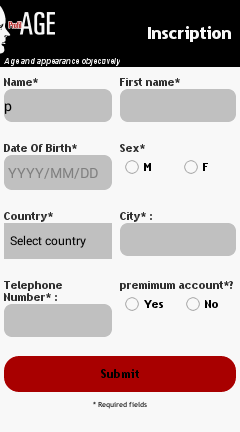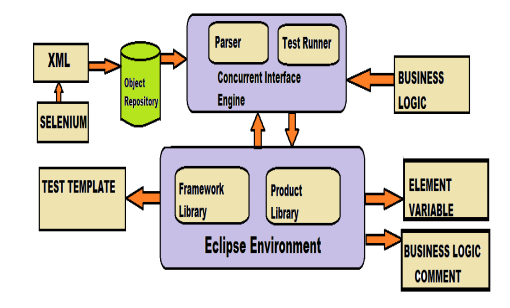|
HTML5 Mobile Web App Development And Website Development For The Future

Many developers have mostly focused their energies on a particular mobile platform especially one of iOS, Windows and Android.
read more... |
Android vs iOS App Development: A Developer's Perspective

The most popular mobile platforms used today are iOS and Android. That is why several applications specifically are developed only for these platforms.
read more...
|
|
 |
PROFILAGE – AN ONLINE GAMING MOBILE APPLICATION
Profilage is an online gaming mobile application designed and developed on the platform of Android, Iphone and Windows phone. It runs on a social networking site connecting people through eLifer.
This application can be accessed by the user registered to eLifer. This creates a game with the features of guessing the age, object comparison, posting the comments to a user as an advice or suggestion.The user can upload a photo from his phone of various image formats.
read more... |

|
|
|
|
Benefits of Selenium as Automation Testing tool

To ensure flawless user experience, it is an absolute essential to test the web applications. Constant changes have to be made to applications as well as websites; even the number of browsers supporting are increasing continuously.
read more...
|
Walking boosts creative thinking

New research shows that walking boosts creative thinking. In a series of experiments, researchers from Stanford University in California compared levels of creativity in people while they walked with while they sat and found creative output went up by an average of 60% while walking.
read more...
|
| |
|
Detailed Articles |
|
HTML5 Mobile Web App Development And Website Development For The Future

Many developers have mostly focused their energies on a particular mobile platform especially one of iOS, Windows and Android. With many development tools in the offing, developers are also trying to take advantage of their current skill-sets by leveraging HTML, CSS and JavaScript during the coding process. Some even use actual programming languages such as C or C++ for creating mobile applications. Native apps highlight the native features of mobile devices including the GPS, camera, contacts, accelerometer and the like.
Mobile Web App Development Tools
PhoneGap is a popular framework for developing cross-platform mobile apps with the help of HTML, CSS and JavaScript. The apps are made to make the best use of core features of the iOS, Android, Symbian and Blackberry platforms including geo-location, accelerometer, and other effects. PhoneGap helps create apps specific to a platform. The use of PhoneGap is popular when one needs to create apps for multiple platforms, while one can compile each app for the particular platform, even though basic coding standards are same for each platform.
Some cross-platform tools including Rhodes, which allow developers to develop native apps for all mobile platforms. One will have to compile the code for each of the platforms separately. Since the tool supports native features, it is an effective tool of app development. Rhodes is available for free under the MIT License. Cloud computing vendors on the other hand, like RhoHub help developers to create applications online without the need to install the latest SDK for each platform. These apps are based on HTML and Ruby and functional through the cloud platform.
The Portable HTML5 Web Apps
Recently developers have been keen to use application development using technologies which are compatible to all platforms. iUI, a tool present in the iPhone User Interface Framework, makes use of JavaScript, HTML and CSS for developing web applications for multiple browsers.
Sencha Touch is a popular HTML5 Mobile App Framework, powered by HTML5, CSS3, and JavaScript working with multiple platforms and HTML5-compliant web browsers. The technology supports touch events including pinching and stretching too. This is open-source software under the GNU GPL license v3. Sencha includes a tutorial featuring geo-location using its API and Google Maps for user's location traceability.
The Google Chrome Web Store is a marketplace for web apps built with standard web technologies and can be accessed and used through a compatible web browser. Web apps developed and available through the Chrome Web Store allows users to access them, through the web browser. No approval process is required for developers to go through, and no fee is levied to submit an application.
Article Source
|
|
|
Android vs iOS App Development: A Developer's Perspective

The most popular mobile platforms used today are iOS and Android. That is why several applications specifically are developed only for these platforms. Both are hot, but Android seems to be in the front when compared in terms of the sales. However, when these operating systems are looked at from an App developer's perspective, the ranking order may look different.
During the application development, some important factors to be considered are accessibility, memory management, learning curve, profits, and inherent advantages presented by a platform. So, let us compare iOS and Android on these parameters.
Accessibility: To develop apps for iOS, you always need a Mac. While on the other hand, Android Software Development gives you freedom in terms of the operating system. Android is an open source platform. Its SDK can be installed on Windows, Linux, as well as Mac, whereas iOS can only be installed on Apple devices. Thus, it can be clearly seen that Android offers more flexibility compared to iOS.
Memory Management: For better functioning of the apps, it is necessary to have an efficient memory management. This memory management can sometimes become a tedious task for application developers. Android has an automatic memory management feature which can be done through Garbage collector. Also, Objective-C offers safe memory management through Automatic Reference Counting (ARC). As per many developers, ARC handles the memory management much better than Garbage Collector. In this, iOS app developers gain with better memory management tools.
Learning Curve: iOS App Development requires Objective-C as the programming language, whereas for developing Android apps, Java programming language is used. Today, Java is a popular language and thus one can find numerous Java code samples on the Internet. Besides, the popularity of Java exists beyond Android development, and is known by the majority of the developers. This, however, is not same in case of Objective-C. To develop apps for iOS, developers need to learn Objective-C. Thus, the learning curve for developing apps for iOS is much higher in comparison to Android.
Fragmentation: Fragmentation seems to be a serious issue for application developers. This threat of fragmentation issues is highly faced by Android application developers due to diverging variants of the platform. Sometimes, the fragmentation issue leads to improper working of the apps on some devices. iOS App developers do not face significant fragmentation issues. This is because if such issue occurs, Apple device owners can quickly upgrade to new iOS.
Software Development Kit: A software development kit (SDK) is essential for application development. Android developers have Android SDK, while Apple offers iOS SDK. Android SDK contains an emulator, while iOS SDK contains simulator. Android emulator can mimic both hardware and software, but the iOS simulator can only mimic the software. You can specify exact hardware requirements to the emulator with the Android SDK, which is not possible with iOS SDK. iOS SDK is fast, and thus you can test and debug the code much quicker compared to Android as its emulator is slow in processing. Thus, when it comes to overall application development, the iOS SDK scores more.
Profits: The sale of Android devices is greater compared to Apple devices running iOS. Thus, if looked at the revenue generated, iOS developers earn more income as Apple device owners are ready to spend more to purchase apps. Whereas on the other hand, Android applications are generally distributed free, and the income generated through ads is not significant.
Article Source |
|
|
PROFILAGE – AN ONLINE GAMING MOBILE APPLICATION

Profilage is an online gaming mobile application designed and developed on the platform of Android, Iphone and Windows phone. It runs on a social networking site connecting people through eLifer. This application can be accessed by the user registered to eLifer. This creates a game with the features of guessing the age, object comparison, posting the comments to a user as an advice or suggestion. The user can upload a photo from his phone of various image formats.
It is a gaming application picking the tendency of human psychology of giving free advice or suggestion or commenting on a particular object or subject being in conversation.
The application is majorly branched out into two modes
- Premium mode
- Non-premium mode
The application will have a Mobile interface through which the user can choose the Premium mode that will allow him to have a grade for a single picture of his face. In the other hand he can choose the Non-premium mode that will allow him to have a category for a single picture of him wearing clothes.
The other functionalities which are being implemented in this application are as follows:
- User Registration and Login Module
- Preference Button
- Log Button
- Disconnect Button.
- Advertising button
- Display uploaded pictures
- Integrating with eLifer – This is required as the Profilage is ultimately connecting the users registered to eLifer.
|
|
|
Benefits of Selenium as Automation Testing tool

To ensure flawless user experience, it is an absolute essential to test the web applications. Constant changes have to be made to applications as well as websites; even the number of browsers supporting are increasing continuously. These facilitate the necessity of having efficient as well as effective test automation solution so that ongoing testing is made possible which leads to rapid bug isolation and ultimately exceptional performance.
The open source toolset called Selenium enables efficient as well as effective GUI or Graphical User Interface test automation for web applications. This set contains various software tools, all of which have various approaches in support of test automation. However, mostly engineers focus on one or at the most two tools to meet their project's needs. But learning about all of them offers a person with various options to approach varying problems since each has particular roles to play. Using this tool offers a multitude of benefits. Some of the notable features are given below.
One time scripting that can be run on multiple browsers- The benefits and features may not be the same with the same script running on multiple browsers, but it does save a lot of hassles. When testing the application on various browser versions, you will definitely feel the enormous advantage of running the same script sets in multiple browsers.
Choosing the language of your taste- With this advantage you get the indirect benefit of easy plugging into the engineering architecture. For example, those familiar with Java, can reap benefits of technical expertise as well as knowledge related to that topic. You can also take advantage of the various tools like reporting tools, build systems, IDE, etc used by your development branch. All you have to do is simply transfer the know-how to the QA team; in fact, in all probability they are already familiar with it.
Integration with ecosystem- If you need to integrate with various suite of tools such as QMetry, Hudson, etc you can easily avail of the solutions which are already out there, making the integration process easier. You do not need to make any investment for purchasing of tools; a test automation infrastructure can be easily created at par with commercial tool suites. If the tests have to be run in parallel, then also there are plenty of solutions available.
Supporting multiple test frameworks- Selenium is actually sort of a GUI driving library and not just a testing tool. Users are allowed by this tool to wrap test scripts in a framework of their taste. They can use whatever framework they like and reap advantages offered by the particular capabilities of the framework.
Software suite with community support- Selenium users are able to take advantage of a number of tools. Firefox plugins can assist you in running as well as recording of your tests. Another tool helps in the taking of tests so that they may be deployed in clustered environment to optimize your resource usage.
Applicability to AJAX- This feature is an inherent one; when the tool works in your browser, the main technology that drives the test case and AUT or application under tests work side by side. This enables immense control over AJAX web application testing.
Through this automation testing tool total test cycle is reduced to 8 hours from 2 weeks. The release cycles become shorter and the nearshore model leads to overall cost reduction by 60%. Testing cases are not only low maintenance but they may be reused as well. There are a multitude of other advantages and features associated with Selenium web testing tool which can be reaped during usage. It also makes it possible for you to introduce benchmarks so that software quality may be increased. For any kind of problem or information, you can always turn to the several web communities as well as excellent quality documents.
Article Source
|
|
Walking boosts creative thinking

New research shows that walking boosts creative thinking. In a series of experiments, researchers from Stanford University in California compared levels of creativity in people while they walked with while they sat and found creative output went up by an average of 60% while walking.
Many people claim that they come up with their best ideas while walking. Steve Jobs, late co-founder of Apple, used to hold meetings while walking, and Mark Zuckerberg, co-founder of Facebook, has also been seen doing the same.
Now, a study by Dr. Marily Oppezzo and Daniel Schwartz, a professor at Stanford Graduate School of Education, may explain why. They report their findings in the Journal of Experimental Psychology: Learning, Memory and Cognition.
They found that the act of walking itself does the trick - it does not matter whether the walk is indoors or outdoors, it has the same effect in boosting creative inspiration.
In one experiment, they found that compared with sitting down, walking indoors on a treadmill facing a blank wall or walking outdoors in the fresh air produced twice as many creative responses.
Dr. Oppezzo says she thought "walking outside would blow everything out of the water, but walking on a treadmill in a small, boring room still had strong results, which surprised me." She says theirs appears to be the first study to look specifically at the effect of non-aerobic walking on simultaneously generating new ideas, and compare it with sitting.
The effect of walking appears to persist for a little while; even if people sat down shortly after a walk, their creative juices continued to flow, the researchers found.
Creative thinking tested for non-aerobic walking versus sitting, indoors and outdoors
To carry out their four experiments, Dr. Oppezzo and Prof. Schwartz recruited 176 college students and other adults, and had them complete tasks that researchers normally use to measure creative thinking.
They placed the participants in various conditions, comparing non-aerobic walking to sitting, indoors and outdoors. When outdoors, for instance, the walkers would walk, and the sitters were pushed in wheelchairs around a pre-determined path on the Stanford campus.
The reason for pushing sitters around in wheelchairs in the outdoor parts of experiments was to give them the same visual movement as walking.
The participants also underwent different combinations of walking and sitting. For example, there might be two consecutive walking sessions, or two consecutive seated sessions, or a walking session followed by a seated one. The sessions lasted from 5 to 16 minutes, depending on the tasks the participants were asked to complete.
Tests of divergent thinking
In three of the experiments, the participants undertook tests of their divergent thinking creativity. Divergent thinking is where you generate ideas by thinking of lots of possible solutions.
For these tests, the participants were asked to think of as many uses as they could for a given object. They were given three objects at a time, and each time, they had 4 minutes to think of as many uses of the three objects as they could.
The responses were marked according to novelty (nobody else in the group had thought of it) and appropriateness (for example, it would be unrealistic to suggest a tire could be used as a ring on a finger).
In these three experiments, the vast majority of the participants scored higher on divergent thinking creativity while walking than while sitting.
In one particular experiment carried out indoors, participants walking on a treadmill scored an average of 60% higher on divergent thinking creativity than when they were sitting.
There was also a fourth experiment that tested a more complex type of creativity. The tester gives the participants prompts to which they have to respond with complex analogies. The more the analogy captures the deep structure of the prompt, the more it scored on high quality. For instance, in response to the prompt "a robbed safe," a response like "empty wallet" would not score as high on quality as "a soldier suffering from PTSD," which captures the sense of loss, dysfunction and violation.
This experiment found that walking outside resulted in 100% of participants generating at least one high-quality complex analogy, compared with only 50% when sitting indoors.
Article Source |
|
|
Itech Solutions |
|














